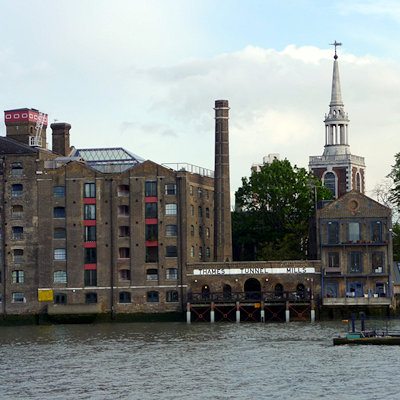
Like us on Facebook
PLACE NAMES


 
|
|
Rotherhithe
|

|
|
 | Pepys House, 2 Cutty Sark Gardens, Greenwich - 0870 608 2000
St. Paul's Churchyard, London - 020 7332 3456
tic@visitgreenwich.org.uk
|
Rotherhithe is a residential district in south east London, England, and part of the London Borough of Southwark. Historically, the area is the most northeastern settlement in the county of Surrey. It is located on a peninsula on the south bank of the Thames, facing Wapping and the Isle of Dogs on the north bank, and is a part of the Docklands area. It borders Bermondsey to the west and Deptford to the south east.
Rotherhithe has a long history as a port, with many shipyards from Elizabethan times until the early 20th century and with working docks until the 1970s. In the 1980s the area along the river was redeveloped as upmarket housing, through a mix of warehouse conversions and new-build developments. Following the arrival of the Jubilee line in 1999 (giving quick connections to the West End and to Canary Wharf) and the London Overground in 2010 (providing a quick route to the City of London), the rest of Rotherhithe is now a rapidly gentrifying residential and commuter area, with current regeneration progressing well around Downtown Road/Rotherhithe Street area and most quickly around Deal Porter Square[2] at Canada Water, where a new town centre with restaurant and retail units as well as new residential developments is emerging around the existing freshwater dock and transport hub.
Rotherhithe is located 4.5 km (2.8 mi) east of London's centre point. Rotherhithe, being an area of the Docklands, has the largest Chinese population in Southwark.
The name "Rotherhithe" derives from the Anglo-Saxon Hrÿðer-hÿð meaning "landing-place for cattle". The first recorded use of this name was in about 1105, as Rederheia. In the past Rotherhithe was also known as Redriff or Redriffe, however until the early 19th century, this name was applied to the whole river front from St Saviour's Dock to Bull Head Dock, this near the entrance to Surrey Water.
The docks were closed and largely filled in during the 1980s, and have now been replaced by modern housing and commercial facilities, but Rotherhithe retains much of its character and its maritime heritage. The largest surviving dock on the south bank, Greenland Dock, is the focal point for the southern part of the district, while there are many preserved wharves along the riverside at the north end of Rotherhithe. St. Mary's Church is at the centre of the old Rotherhithe village, which contains various historic buildings including the Brunel Engine House at the south end of the Thames Tunnel.
Canada Dock was the dock basin furthest away from the River Thames in the Surrey Docks complex, and it was linked to Albion Dock and Greenland Dock at its northern and south-eastern extremities via the Albion Canal. The dock has been remodelled, and its northwest half retained as an ornamental lake, renamed Canada Water. The canal has remained as a walkway and water feature within the redeveloped area.
The sustainable transport charity Sustrans has proposed the construction of a bicycle and pedestrian swing bridge from Rotherhithe to Canary Wharf, and cost-benefit and feasibility studies were undertaken. In January 2009 the London Mayor Boris Johnson said he would not fund the bridge, citing budget cuts due to the credit crunch, with the result that the project was effectively put on ice. However the idea is still being supported by Sustrans.
There are two Anglican churches in Rotherhithe St. Mary's Church, and Trinity Church. There are two Roman Catholic churches: St Peter and the Guardian Angels, and Our Lady of the Immaculate Conception.
King's Stairs Gardens is a small park on the river towards the Bermondsey boundary. In September 2011 Thames Water announced that they wanted to build an access shaft for the "super-sewer" Thames Tunnel. Due to local action by The Save King's Stairs Gardens Campaign, which collected over 5000 signatures, it seems as of March 2011 that Thames Water will build the access shaft elsewhere, if the local community agrees.
Severn Islands Leisure Centre occupies the site of the old Rotherhithe Town Hall. The building ceased to be a town hall in 1905 when the former Rotherhithe Council merged with the old Bermondsey Borough Council and the new council used premises in Spa Road. The old Rotherhithe Town Hall became a library and a museum. It was razed to the ground by repeated bomb hits and near misses during the Second World War.
Rotherhithe had its own general hospital, St Olave's Hospital, on Lower Road close to the old town hall. Built originally in the early 1870s on land adjoining Rotherhithe Workhouse, it became the infirmary of St Olave's Union in 1875, and was renamed St Olave's Hospital in 1930. Subsequently, becoming part of the Guy's Hospital Teaching Group in 1966, it closed in 1985 and the site has been redeveloped into the residential Ann Moss Way.
The Terriss Theatre (named after the actor, William Terriss) opened in 1899 and was later renamed the Rotherhithe Hippodrome of Varieties. It stood on Lower Road by Culling Road. It was bombed in the 1940's and stood empty until demolition in 1955.
When the roundabout facing the Rotherhithe Tunnel was redeveloped in the early 1980s, several 19th century buildings were demolished including a school and a nunnery. A public house, the "Europa", described in an early 20th-century history of the area as one its oldest, was also demolished. Max Bygraves frequently played piano there at weekends.
|
 Feel free to Email me any additions or corrections Feel free to Email me any additions or corrections
LINKS AVAILABLE TO YOUR SITE
| |





